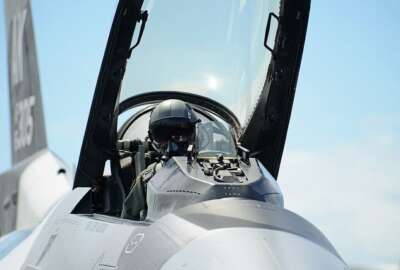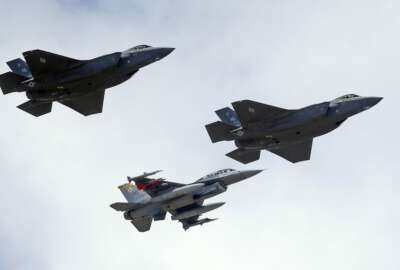
Pilot Training Next calls on industry to help improve pilot learning
The Air Force's futuristic program for pilots needs help from business to advance.
Best listening experience is on Chrome, Firefox or Safari. Subscribe to Federal Drive’s daily audio interviews on Apple Podcasts or PodcastOne.
The Air Force’s futuristic new way of training pilots is starting up again in January, and it’s calling on industry to help improve its process.
The Air Force’s Pilot Training Next program gives pilot trainees their own flight simulators to practice on whenever they like, tries new ways to train pilots and collects biometric data to help teach future pilots.
Now the Air Force is using AFWERX, an innovation hub started by the service, to buy new technologies that may help the Pilot Training Next mission.
Industry “is going to help us look for solutions to the problems that we faced over the last six months when we ran Pilot Training Next 1.0 in Austin,” said Johnathan Wiley Bucey, a trainer for the program told Federal News Radio. “What we are requesting is some specific adaptations of [commercial-off-the-shelf] technologies.”
AFWERX started the challenge Wednesday; it will last until Oct. 5. It asked industry to submit ideas in data science, artificial intelligence, biometrics, simulator development, virtual reality and adult education.
The organization hopes to find people and companies with prototypes or full blown ideas that are already earning revenue.
Pilot Training Next is specifically calling on industry to provide technologies that will help build a learning ecosystem that allows for real-time collaboration, cloud-based documents and an online knowledge repository. It’s also looking for debriefing tools, and smart gradesheets that are accessible from the internet so students can track their learning.
The program has $500,000 in prototype and experimentation funding and there are chances for government contracts.
AFWERX uses a wide range of contracting options for businesses to work with the government, including cooperative research agreements. AFWERX has an integrated team, based in one location that can award contracts and cooperatives quickly.
Bucey said Pilot Training Next hopes to do a better job this time around of collecting biometric data and analyzing it.
“We want to be able to rapidly pull that data back up in order to use that as a debriefing tool and also to use that to gain insight as to the specific performance of that student. We are trying to drive toward that individualized learning atmosphere as opposed to traditional undergraduate pilot training, which is a written syllabus and every single student is going to follow the exact same lesson plan from beginning to end,” Bucey said.
While that has helped get the masses through training, it doesn’t take into account students who can accelerate their learning or need specialized training.
“It’s actually amazing what I’ve seen,” said Capt. John Joern, a Pilot Training Next instructor, in an interview with Federal News Radio. “A traditional ride in a T-6 for a student in a traditional pilot training base looks like the instructor flying about 95 percent of it, the student maybe flying about 5 percent of it when they are not making gross mistakes. Here, when I took a student up for their very first ride, they’re doing competencies well into the middle of [a traditional] program and they’re flying about 90 percent of the sortie, while I’m just trying to demo the 10 percent.”
Still, while the individualized training seems to be working, the plan for the use of biometrics is still finding stable ground. Bucey said the program was not able to use the data as they had hoped. Scott Van de Water, deputy director of Pilot Training Next at Air Education and Training Command, said in July that biometrics and data analytics were a more challenging part of the program.
“Where we see this going in the medium term is having a little bit more data analytic capacity,” he said. “But in order to do data analytics you need to have robust data sets and you need to be able to dissect those data sets and make sense of them in a meaningful way. We need to spend a lot of time looking at how to understand the data we are gathering in order to make sure the conclusions we are drawing are valid and in order to make those decisions based on solid ground.”
Copyright © 2025 Federal News Network. All rights reserved. This website is not intended for users located within the European Economic Area.
Scott Maucione is a defense reporter for Federal News Network and reports on human capital, workforce and the Defense Department at-large.
Follow @smaucioneWFED





